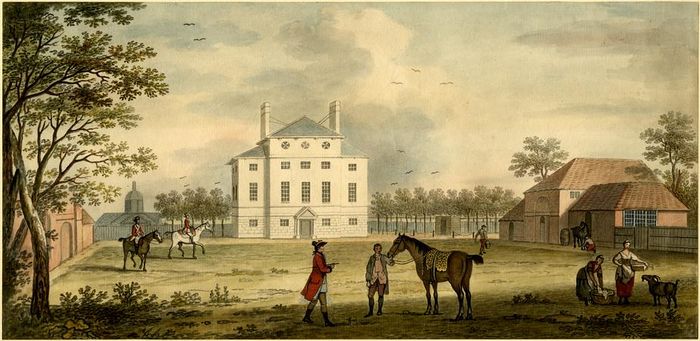Annotation:Maid of the Oaks
X: 1 T: Maid of the Oaks C: J-9 M: 6/8 Z: R: jig F:http://jc.tzo.net/~jc/music/book/RJ/jig/Maid_of_the_Oaks_RJ.abc K: D f| "A"edc "D"dcd| "A"edc "D"d2A| "G"Bcd "A"efg| "D"f3 d2f| "A"edc "D"dcd| "A"edc "D"d2f| "E"efd cdB| "A"B3 A2 :| |:\ f| "A"ece ece| gee ece| "G"Bcd "Em"efg| "D"d3 "A"c2A| "G"Bcd "D"AFA| "G"Bcd "D"A2 g|fed "A"edc| "D"d3 d2 :|
MAID OF THE OAKS. AKA - "Maid of the Oak." English, American; Jig (6/8 time). D Major. Standard tuning (fiddle). AABB. This is the tune for a country dance of the same name. The "Maid of the Oak(s)" appears in a large number of late 18th century musician's manuscripts in North America, including those of keyboard player Elizabeth Van Rensselaer (Boston, 1782), John and William Pitt Turner (Norwich, Conn., 1788), flute player Ralph Pomeroy (New Haven and Hartford, Conn., 1790), Caroline Rachel Frobisher (Montreal, 1793), flute player Micah Hawkins (New York, 1794), and Cushing Eells (Norwich, Conn., 1789). Country dance directions also appear in several other copybooks and a few publications such as John Griffiths' Collection of the Newest and Most Fashionable Country Dances and Cotillions (Providence, Rhode Island, 1788) and John Trumbull's Gentleman & Lady's Companion (Stoneington, Conn., 1798).

After some superb exhibitions of transparent scenery, several characteristic airs, and elegant dances, Mr Oldworth … proclaims Maria his only daughter and gives her to Sir Harry. After a dance of Cupids, Hymen, &c. … offering them eternal wreaths, the Druid of the Oaks, freed by the present powers of Beauty from that sequestered habitation to which by mystic spells he had long been doomed, appears to ratify their union, and astonishes the spectators by his magic influence, in a glorious vision of that felicity the virtues of the happy pair had so justly insured. An admirable vaudeville, and a grand dance, conclude the dramatic entertainment.
Burgoyne's work, his first play, included a Fête Champêtre with singing and dancing, with dances by famous period dancers and choreographers "Slingsby...Aktins, Como; Giorgi, Sga Crespi, Mrs. Sutton, &c. and Sga Hidou,...the Ballets by M. Larevier'." Dance researcher Moira Goff finds that Burgoyne based part of his play on an entertainment by Lord Stanley (Edward Smith Stanley, later 12th Earl of Derby) in June, 1774, six months before the play's premier. Stanley had given a Fête Champêtre at his country seat and hunting lodge, The Oaks, near Epsom in Surrey, to celebrate his upcoming marriage to Lady Elizabeth Hamilton. According to the General Evening Post (June 9-11, 1774) there were several entertainments for the guests, including "an infinite number of persons habited as peasants who attended swings and other amusements, and occasionally formed parties quarrees to dance quadrilles" [2] Burgoyne happened to be Stanley's uncle and was himself in charge of the June Fête Champêtre at the Oaks; he enlisted two close and famous friends, actor-manager David Garrick and the architect Robert Adam, and it was Garrick who arranged the dancing, instrumental and vocal music. Why let such good material to to waste? Burgoyne refashioned the spectacle into a highly profitable stage version "for which the original libretto of the masque was stretched from two to five acts by including additional songs, dances and theatrical interludes to recapture the spirit of the enchanting rural entertainment"[3].
It may be that the name "Maid of the Oaks" was well-known to be the work of Burgoyne, and that the popularity of the tune with American musicians (as demonstrated by its numerous appearance in period copybooks) of the latter 18th century is in some sense a tweak of the nose at the British.
- ↑ General John Burgoyne was a British army officer and playwright as well as a politician who sat in the House of Commons from 1761 to 1792. He is best known for his role in the American War of Independence when he surrendered his entire army at Saratoga in October, 1777.
- ↑ This and the preceding passages were originally quoted by Moira Goff in her blog "More Quadrilles in 18th-Century London," danceinhistory.com [1] accessed 8.7.2020.
- ↑ Doderer-Winkler, Melanie. "Magnificent Entertainments: Temporary Architecture for Georgian Festivals". London and New Haven, Yale University Press for The Paul Mellon Centre for Studies in British Art, 2013. ISBN 0300186428 and ISBN 978-0300186420.

